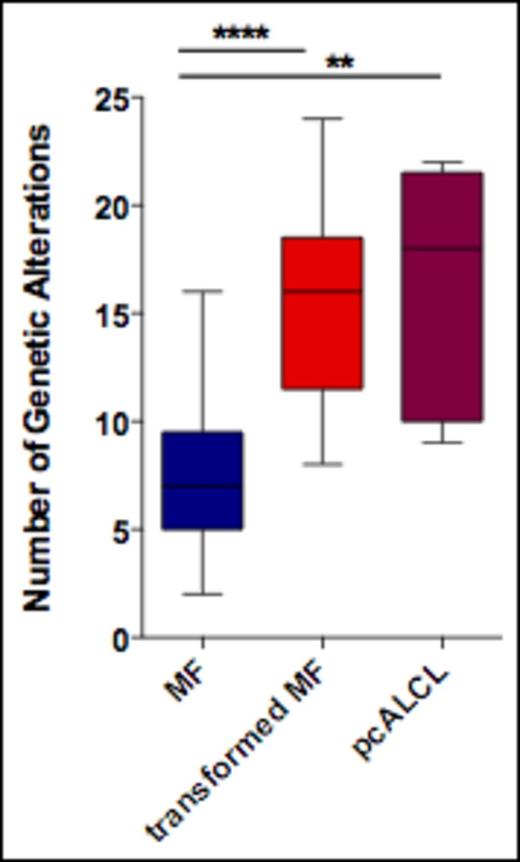Abstract
Cutaneous T-cell Lymphoma (CTCL) is a heterogeneous group of diseases, derived from skin resident or skin homing T-cells, with Mycosis Fungoides (MF) and Sezary Syndrome (SS) being the most common subtypes. Although CTCL is the best-studied group among T-cell malignancies, our understanding of its pathogenesis remains limited, due to the paucity of comprehensive, large-scale genomic studies. Recent whole exome and targeted sequencing approaches have primarily elucidated mutations in genes affecting immune synapse signaling (PLCG1, CD28, JAK3) and epigenetic modulation (ARID1A, DNMT3A) in both MF and SS. In search of novel genetic alterations, we applied deep targeted sequencing in 71 freshly cryopreserved skin or peripheral blood samples derived from 61 patients with CTCL, including patients with MF, SS, primary cutaneous anaplastic large cell lymphoma (pcALCL), pleomorphic small/medium sized CD4+ CTCL and CD8+ CTCL. Genomic DNA was sequenced for the entire coding region of 585 known cancer-related genes on a HiSeq2500 Illumina instrument with a mean depth of 1000X. Sequences were analyzed for base substitutions, in-frame or frameshift insertions and deletions and splicing variants. Known germline variants reported at dbSNP and the 1,000 Genomes Project data were excluded, while confirmed somatic variants previously reported at the COSMIC database were included. Only variants with an allele frequency above 2% were further analyzed, in order to eliminate false positive data. Recurrent mutations were identified in genes responsible for tumor suppression (TP53, FAT1, FAT3), DNA damage response (ATM, MDC1), DNA mismatch repair (MSH3), chromatin remodeling (ARID1B), histone methylation (MLL2, MLL3, KDM6A) and DNA methylation (DNMT1). Moreover recurrent mutations pointed to robust activation of the three following signaling pathways: Receptor Tyrosine Kinase (IRS2, FOXO3) JAK/STAT (JAK3, STAT5A/B, SOCS1) and NOTCH (NOTCH1, NOTCH2). Finally, at a subclonal level we paradoxically identified mutations of the Androgen Receptor (AR) gene. Interestingly, the presence of large cell features correlated with a higher accumulation of molecular events, since transformed MF and pcALCL had a significantly higher number of genetic alterations compared to untransformed MF (Figure 1). In sum, the genomic landscape occurring from our targeted sequencing approach highlights the pathologic complexity of these neoplasms, suggesting multiple non-redundant mechanisms leading to lymphomagenesis. The characterization of this cohort is expected to provide an opportunity to comprehend intra-CTCL molecular heterogeneity and offer a better classification of CTCL entities along with novel potential therapeutic targets.
Levine:Foundation Medicine: Consultancy; CTI BioPharma: Membership on an entity's Board of Directors or advisory committees; Loxo Oncology: Membership on an entity's Board of Directors or advisory committees. van den Brink:Merck: Honoraria; Boehringer Ingelheim: Consultancy, Other: Advisory board attendee; Novartis: Consultancy, Membership on an entity's Board of Directors or advisory committees; Regeneron: Honoraria; Tobira Therapeutics: Other: Advisory board attendee. Palomba:Janssen: Consultancy.
Author notes
Asterisk with author names denotes non-ASH members.


This feature is available to Subscribers Only
Sign In or Create an Account Close Modal